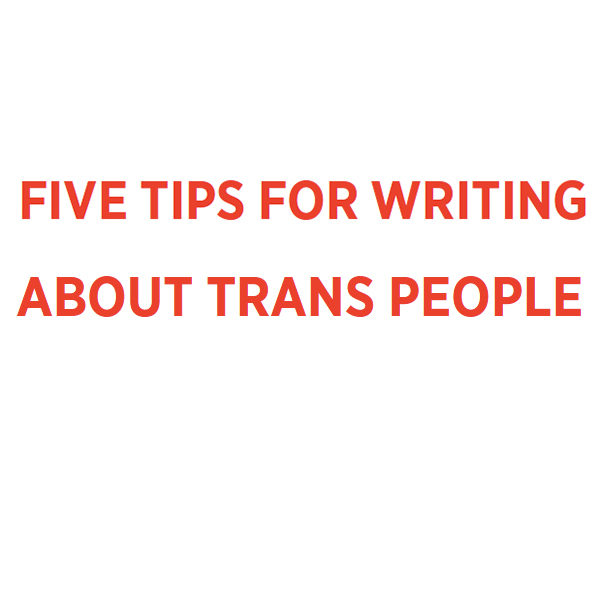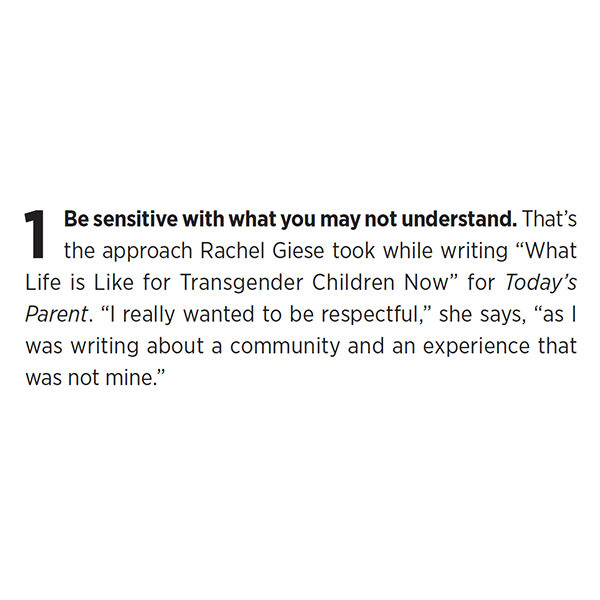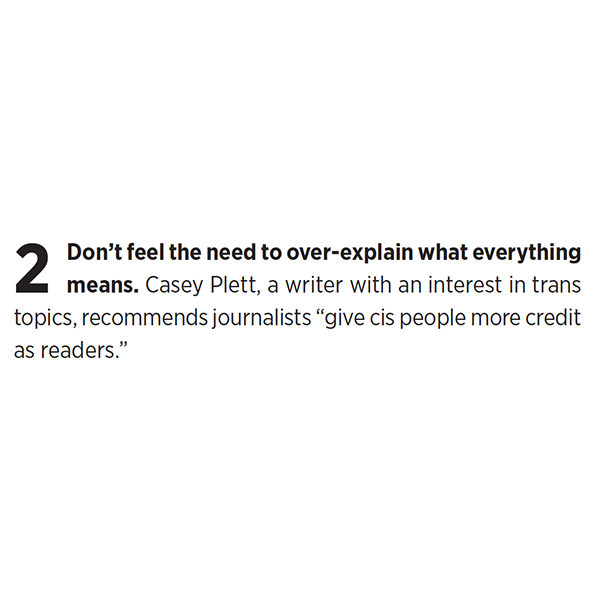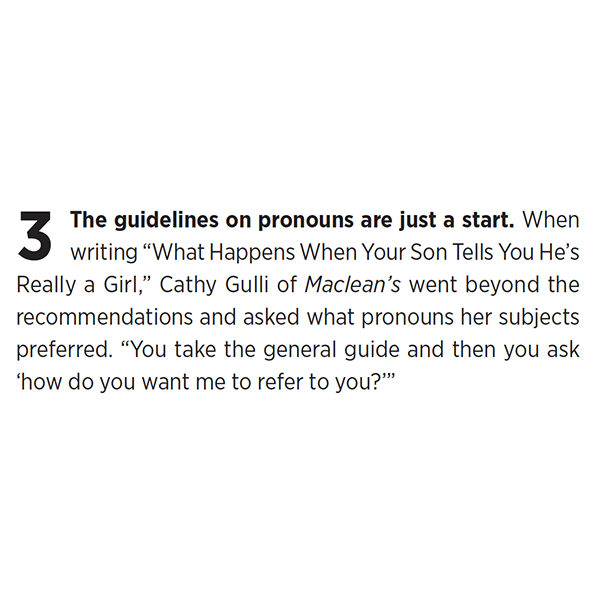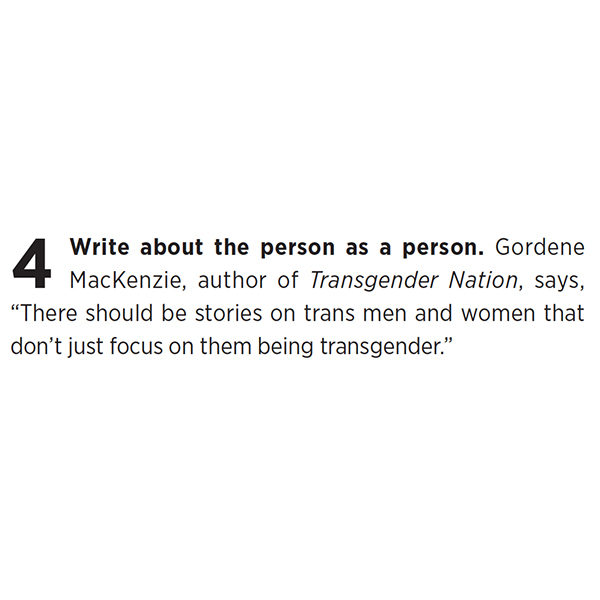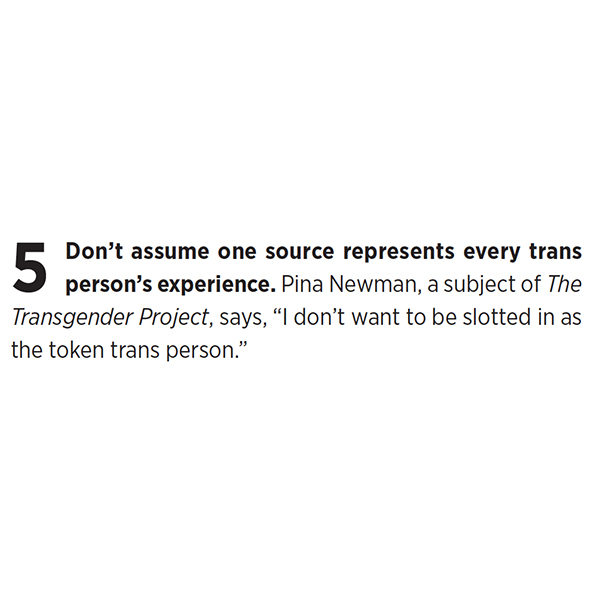The Next Frontier
LGBT coverage is becoming more nuanced, one group at a time. Next step: trans people
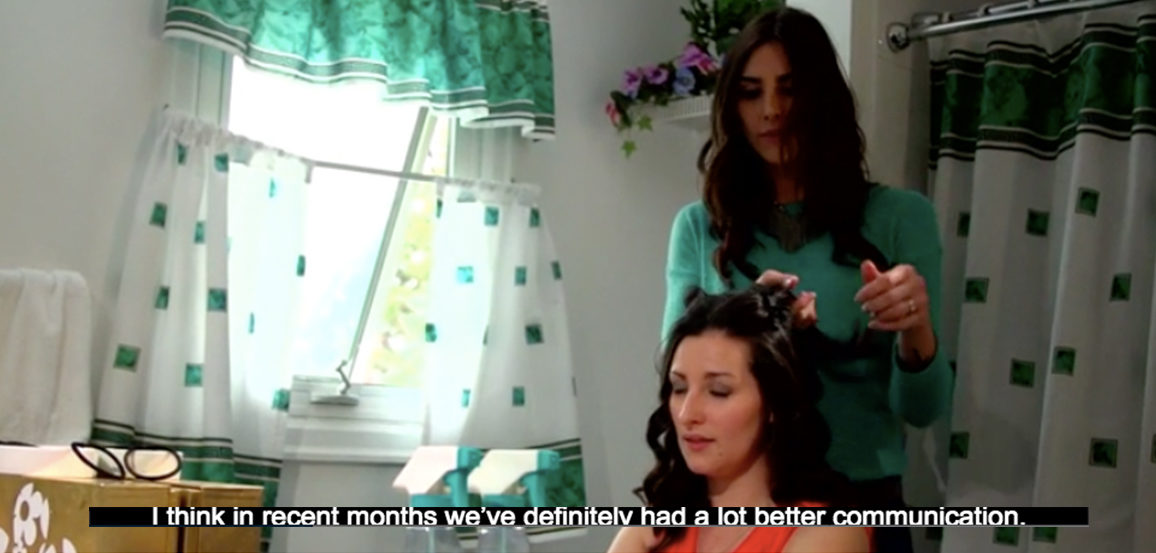
The Transgender Project seeks to tell its subjects’ life stories beyond their gender identities. Image courtesy of The Transgender Project
The camera captures Pina Newman and her sister Alyse directly within its frame. In October 2014, Newman is clipping her sister’s hair into sections and curling it with practiced ease in the washroom of the Winnipeg home where they grew up. The window, covered by sheer, white curtains with green squares, is visible to the side, matching the shower curtain behind them. Scattered makeup, face wash and hair care products litter the countertop—a common sight in washrooms shared by sisters. Unseen in the shot, Kevin O’Keefe, director and producer of The Transgender Project, stands outside the door asking questions.
The project began as a website that includes profiles of Canadian trans people in short video snippets. It then became a television doc series called Am I a Boy or Girl. Right now, the sisters are talking about how their relationship was affected by Pina’s transition. Pina admits, “I really made everything all about me,” while Alyse says it was confusing.
O’Keefe wanted to show the whole lives of trans people in these episodes. Having the sisters do something they’d normally be doing is less formal than a conventional Q & A and allows them to speak naturally. Pina always felt safe as a subject of the series, which premiered in October 2015 on ichannel, and thinks viewers saw the challenges alongside the positives. She has a great relationship with her sister, but she says the episode also shows that she struggles, just like everyone else.
Transgender people have started appearing more frequently in North American newspapers and magazines, on radio and TV and in documentaries. This makes sense given the timeline of activism, wrote Susan Stryker—who teaches gender and women’s studies at the University of Arizona—in her book Transgender History. Coverage of homosexuality evolved from prejudice to acceptance, and next on the list is trans rights.
For mainstream news outlets, this means journalists have to figure out how to report on a community few are familiar with, let alone part of.
Only a few years ago, stories often included insensitive remarks about trans individuals and made unfair assumptions about the community. But journalists are now becoming more sensitive to the way trans people want to be identified and the difficult issues they face, including discrimination, murder, suicide and homelessness. It’s a good start, but the trans community wants to be better integrated into the news on a regular basis, with these issues investigated and discussed in greater depth.
Journalists who produce feature stories and documentaries have the time to research and understand the trans community in a way daily news seldom can. That’s why The Transgender Project is an excellent example of reporting on trans people. Some journalists’ understanding of the trans world is growing, but a more sensitive approach to the issues is still needed in daily news.
Early reporting on gay issues parallels the evolution of trans coverage today. Before the 1960s, gay people were usually depicted as dangerous psychopaths and sexual deviants. In 1964, journalist Sidney Katz worked with James Egan, a pioneer of gay rights advocacy in Canada. With Egan’s help, Katz wrote a two-part series for Maclean’s that documented the “secret lives” of gay men in Canada. Katz introduced readers to people who were generally hidden from the public eye at the time. They are “ordinary citizens in all respects but the one that makes them criminals before the law and outcasts in society.” He raised the “homosexual problem”: that they could not live their lives the way they wanted because the criminal code made them outlaws due to their sexual orientation. They couldn’t come out if they wanted jobs and often couldn’t even secure housing. Katz wrote about Egan’s experiences, giving him an outlet for his views about the need for social change. It was one of the first articles to look at homosexuality in a positive light, but it would be years before publications began accurately reporting on the gay community on a regular basis.
Today, replace “gay” with “trans” and we find journalism gradually developing a more sophisticated—and sensitive—approach. The reporting on Jenna Talackova, which spurred trans rights in Canada much like Caitlyn Jenner did in the U.S., can be seen as a turning point. Talackova was the first Miss Universe Canada contestant to identify as transgender. Selected in 2012 to compete in the pageant, she was disqualified when organizers discovered she was a trans person. Working with a lawyer, she fought the ruling. Before the case reached the courts, the organizers reversed their decision.
Talackova made it to the top 12 and received one of the “Miss Congeniality” titles. The story led to some of the first widespread positive coverage of trans people in Canada. “She’s all congeniality, pageant ready,” wrote Nancy J. White in the Toronto Star. White quoted Talackova talking about her own life: “You don’t get the sun without the rain…That’s how my story went.”
Although many trans people resent how journalists have portrayed them in the past, coverage in Canada has improved. When there is legitimate news, mainstream outlets usually try to get to it quickly and respectfully. The Huffington Post runs blog posts by trans writers and publishes pieces on a wide range of topics related to trans issues, including discrimination in schools and violence against the community. Lisa Yeung, managing editor of lifestyle, says the site just publishes whatever editors consider newsworthy. “If a story is important,” she says, “we’ll make the effort to cover it.”
When Alberta added gender identity and gender expression to the list of categories protected by the provincial Human Rights Act in December 2015, many news outlets covered the story well. A Canadian Press report, picked up by several publications, quoted trans people, not just government officials. The Edmonton Journal’s coverage educated readers about the percentage of trans people who attempt suicide and who feel unsafe in their schools and workplaces. CBC published an article written by a trans woman involved in the announcement and included subsections explaining the reasons—such as mental health and safety—the amendment was necessary.
When Jenner appeared on the July 2015 cover of Vanity Fair, CBC ran a story with a different angle. Instead of focusing only on the celebrity, Aleksandra Sagan wrote about how different Jenner’s life is from the majority of trans people. In “Caitlyn Jenner’s transition doesn’t represent most transgender experiences,” Sagan wrote, “what’s being presented as a seemingly fairytale story is not the reality for many transgender people who face long wait lists and costly procedures that public health services don’t necessarily cover.” In a similar story Maclean’s published online, Emma Teitel recounted the widespread response on social media to the Vanity Fair story, which she says was mostly positive. “But her swift acceptance by the public isn’t typical.”
Before Jenner, Cathy Gulli of Maclean’s wrote a detailed feature on trans issues in January 2014. The idea came to her after a copy of a book called Chasing Rainbows: Exploring Gender Fluid Parenting Practices landed on her desk. She knew there was a story there, but she didn’t realize just how important it was until she got deep into reporting. The piece gives a balanced perspective on the pros and cons of allowing kids to transition, covers how parents can tell if a child might be trans and points out that it is not just a phase. The article also gets to the hard stuff: “These kids have among the highest rates of isolation, harassment, depression, addiction, self-mutilation and suicide of any population.” Gulli says this is one of the features she’s more proud of. For her, it was about “creating a platform for these families to tell their stories.” While reporting, Gulli asked her sources which pronouns they would like her to use in the story, and went with that. Some news outlets now follow guidelines on what language to use when speaking or writing about trans people. Some use recommendations created by GLAAD, a U.S.-based media monitoring organization founded by members of the LGBT community. Organizations such as the Manitoba-based Rainbow Resource Centre can also be helpful in educating staff about accuracy and awareness. CBC regularly updates its own style guide to help its journalists with trans stories and other language sensitivities.
This is helpful because some journalists don’t understand the importance of sensitive pronoun usage. Common mistakes include using transgender as a noun instead of an adjective, which reduces people to just one of their qualities; referencing a subject as being “born a man” or “born a woman”; and applying the wrong pronoun. To be fair, it can be difficult for someone who is cisgender (a term for those who identify with the gender assigned at birth) to understand why trans people are so sensitive to language. For most cisgender males, walking into a men’s washroom is just walking into a washroom. For many trans people, walking into a washroom is a daily challenge, reaffirming their difference as surely as when someone uses an incorrect pronoun.
Within the trans community, identifying someone incorrectly is no different than writing a racial slur. Mike Strobel, a Toronto Sun columnist who has drawn criticism for his writing about trans people, believes that being careful with language “is blurring an important issue with silly semantics.” His message about the trans community is not intended to offend: in a September 2015 article, he wrote, “One by one, ‘minorities’ overcome fear and bias to become accepted (more or less) by the rest of us—and even trendy.” But in this same column, he used the word “transgenders,” making the adjective into a noun. He also referred to Jenner as “nee Bruce,” even though using someone’s past name is taboo unless necessary (in this case, most people know who Jenner is). This may seem like “silly semantics” to Strobel, but to many trans people, their birth gender is not who they are, or ever really were.
Another example of improper word usage can be seen in Pamela Roth’s 2012 article “Good News for Transgenders,” which used the word “transgendered,” something that goes against many style guides today (we don’t say a gay man is “gayed”). But, it did explore an important issue—people getting fired from jobs after coming out.
Articles that identify trans people accurately can have greater impact among readers. The good news is that observers such as Christin Milloy, a journalist and trans activist, see gradual improvements, even at the conservative Sun papers. A story by Jonathan Sher in the Toronto Sun, “Suicide rate much higher for transgender Canadians: Study,” written just three years after Roth’s article, followed the guidelines on trans people while covering a difficult topic. Sher’s message: it’s not being trans that creates high suicide rates; it’s the treatment trans people receive. Another challenge—one that represents a problem for journalism in general—is diversity. There are few stories about Black or homeless members of the trans community, says gender specialist Rupert Raj. Even O’Keefe, who wanted to show a range of diversity in his series, didn’t entirely succeed. He included both older people and some who struggled financially, but most of his subjects were white.
The similar content in most trans news stories, along with legal and political changes, inspired former Toronto Life associate editor Caroline Youdan in early 2015. She wanted people to see what life was really like for a trans person in Toronto. “My Trans Life” consists of five people telling their stories. Youdan’s timing worked out well: about a month after she started working on the story, Jenner came out as a trans woman, and the international media became obsessed with trans stories.
Despite Youdan’s quest for diversity, the subjects of “My Trans Life” weren’t new faces in Canadian journalism. Alex Abramovich was a subject in a CBC documentary called Transforming Gender; Sophia Banks was featured in a video on the Maclean’s website; Savannah Burton was in The Transgender Project; and Alec Butler was the subject of articles in Now and the Star. Like O’Keefe’s series, the Toronto Life stories had upbeat endings—not necessarily the norm in the trans community. Still, it was an effective feature and, as Youdan explains, “We did the best we could in the time that we had.”
What’s the next step for reporting on trans people in Canada, according to trans people?
Pina, a nursing student, Christin, a journalist, and Casey, a writer, share their thoughts.
Pina
Christin
Casey
The tight deadlines of daily news can make it harder to tell complex, nuanced stories about minority communities. Journalists working on long-form pieces have more time to think about how they approach their subjects. When O’Keefe arrives at the Newman home in Winnipeg, Pina is still eating breakfast. He knows better than to rush her along, as successful filming that day depends on the calmness of the household. While Pina finishes, O’Keefe sits with her father, Francis, to look at photos—the relationship-building part of the job. After the team films some B-roll of Pina walking up and down the street, Alyse appears with coffee from Tim Hortons for everyone.
O’Keefe’s first interview of the day is with Pina and her parents. The three of them take their seats, Pina on a chair and her parents on a couch. One section of the episode begins with Francis crying and saying, “I still grieve…” before choking up. Alyse, who had been watching from the staircase just outside the room, walks by and throws a Kleenex box on his lap.
Sitting silently next to her husband, Pina’s mother, Barbara, looks like she could have been crying moments ago. Still, she’s poised and serious.
Pina has her hand on her father’s knee, and he puts his hand on top of hers. Struggling to continue, he looks at his daughter and says, “…I still grieve the loss…the loss of my son,” before pinching the bridge of his nose and continuing to cry. He moves his hand abruptly from under Pina’s, but she doesn’t flinch.
“My father never shows emotion,” she explains in a later interview. But O’Keefe’s goal is to make his subjects feel so safe that they express their honest feelings. After a break, the camera starts recording just as Pina pulls away from hugging her father and returns to her seat. Francis is now able to get through the sentence: “It seemed an awful lot like the loss of my son.”
O’Keefe, who started working on The Transgender Project in the summer of 2014, says trust was by far his biggest challenge, which would ring true for any journalist covering an unfamiliar community. But O’Keefe knew that many trans people felt they had been “burned” by reporters in the past, so he had to tread especially carefully. He even made sure each member of the crew had sensitivity training.
O’Keefe let his subjects have a say in what they wanted to talk about. Pina thought it was important to discuss her surgery and show her face without hair extensions or makeup, while other people wanted to steer clear of discussing physical changes. But this approach, requiring lengthy negotiations beforehand, is only possible on projects with a longer time frame.
About a year after the filming in Winnipeg, Pina walks swiftly into a café on the Ryerson University campus. The nursing student looks around for me. It is easy to forget I don’t actually know her in person despite having seen her in the episode of Am I a Boy or Girl. After saying how great it was to work with O’Keefe and his team, she adds that this type of reporting isn’t enough. She says we need more on the “murders that go on in our community. The hard stuff, not just ‘here we are, advocating for all-gender washrooms.’”
And she’s right—we do.
Canadian news outlets have started telling the real life stories of trans people and the issues they face each day. Now, journalists just need to keep getting better at it.
by Blair Mlotek
Blair Mlotek is the Online Handling Editor for the Spring 2016 issue of the Ryerson Review of Journalism.



